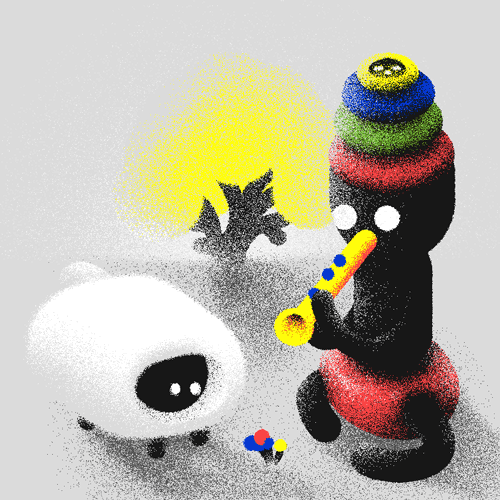

If you grew up watching the old Disney classics, you might remember the psychedelic scene in Dumbo where pink elephants dance all over the screen, changing form and size along the way, accompanied by sweeping bombastic sounds. If you rewatch it now, you feel like you’re in some kind of weird dream (and you wonder how this didn’t scare you to death as a child).
A similar sensation occurs when you look at the dark and trippy loops of Ori Toor. They might even be weirder, as Ori creates abstract but oddly figurative forms, rather than animated pink elephants..
“I don’t want to make a character that is pretty specific, I want them to be abstract things,” Ori says. “By simply putting a plain face on them, I turn them into characters that are pretty general in their own way.”

Ori launched Looopism as an outlet to experiment and showcase his skills. “A few years ago I went freelance and, because there’s not a steady rhythm of jobs coming in, I needed something to keep myself occupied and to give meaning to the days,” he explains.
And this creative project definitely shows off his abilities; not only has it been immensely popular online, it has paid off for his career too leading to a wide range of commissions, from festival visuals to t-shirt prints.
I don’t want to make a character that is pretty specific, I want them to be abstract things.

But Ori has a very set way of working with clients, which he spells out before accepting any commission. Ori doesn’t sketch, he doesn’t do trial-runs; he just starts.
“Often people get a folder with images to look at and draw ideas from. It’s like when you are a student, and you look at design blogs to get inspiration and everything looks amazing. That makes you feel really worthless and you think to yourself, ‘I can’t do that.’
“For me, references sometimes make me feel like that. I need to ignore things that exist and just do my own stuff. Otherwise I get kind of scared.”

As well as being disenchanted by the visual bombardment of the web, Ori has concerns about the effect seeing other people’s work can have on his own creations.
“When I use a reference, I actually start drawing it like a still-life and I don’t want to do that,” he says. The key to keep pushing his own practice forward lies in his experimentations – with different colors, different techniques, different software. You see this when browsing through his website as you see his work change, for example from a bright color palette to a darker, more sinister tone.
“Sometimes there are bad moments and sometimes there are good moments – you know, that’s life. Particularly when I am in a dark place, I might want to express that, or I might want to go the other way, to comfort myself. When you see something really colorful it doesn’t have to mean that I am super happy, but when you see something really depressing that doesn’t mean I am depressed either.”
But the freewheeling, improvisational nature of his process can cause problems with new clients. “I don’t like it when someone from the outside decides what I should make. I know that’s how people usually work, so sometimes I just write to clients and say hey, I’m not trying to be an asshole, it’s just that I work best this way!”




